Structural Organization in Animals
Table of Content
- Define tissue
- Epithelial tissue
- Connective tissue
- Muscle tissue
- Neural tissue
- Organ and Organ System
- Earthworm
- Cockroach
Define tissue
Group of cells working together to bring out a function is known as tissue. The advantage of tissue in multicellular organisms is division of labor.
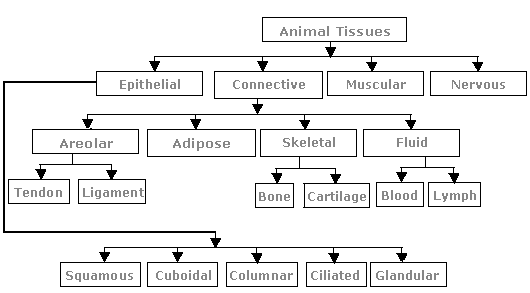
Fig. 1. Classification of animal tissue
Animal tissues: There are four basic type of animal tissues found:
Epithelial tissue
Tissues that cover the outer and the inner lining of various organs is known as Epithelial Tissue. Cells of the epithelial tissue are compact.
Simple epithelium
It is made up of single layer of cells that lines the ducts, body cavities and tubes.
Types of Simple epithelium
- Squamous epithelium: It has flattened cells with irregular boundaries. It is present in the lining of blood vessels and alveoli of lungs.

Fig. 2. Squamous epithelium
- Cuboidal epithelium
It is made up of cube-like cells.This type of epithelium is meant for secretion and absorption. For Example, ducts of glands.
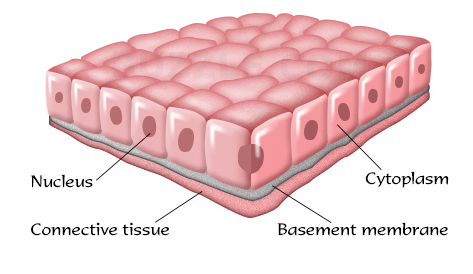
Fig. 3. Cuboidal epithelium
- Columnar epithelium: Cells of columnar epithelium is tall and slender. They are meant for secretion and absorption. It lines the stomach and intestine.
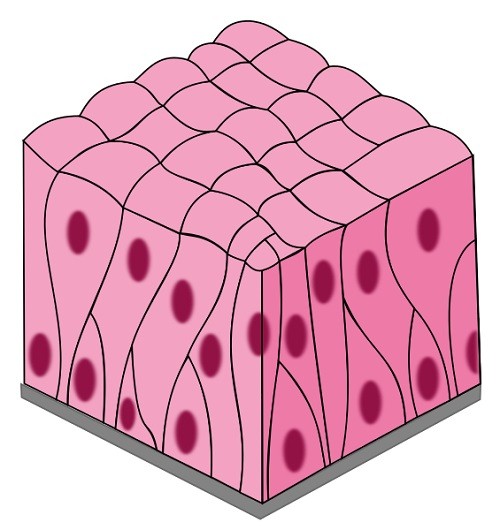
Fig. 4. Columnar epithelium
- Ciliated epithelium: When cilia are present in columnar and cuboidal epithelium they form ciliated epithelium. They are present in fallopian tube, bronchioles etc.
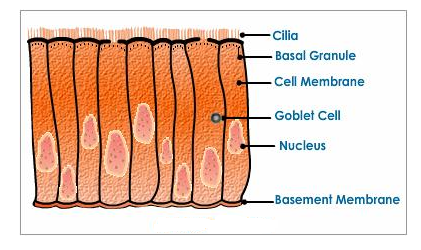
Fig. 5. Ciliated epithelium
Compound epithelium
This type of epithelium is made up of more than one layer of cells. It is protective in nature and present in skin, lining of buccal cavity, pancreatic ducts etc.
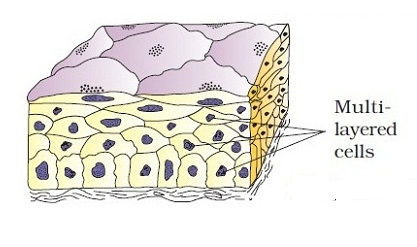
Fig. 6. Compound epithelium
Three types of cell junctions are found in the epithelium- tight junctions, adhering junctions and gap junctions. Tight junctions prevent the substances from leaking across a tissue. Adhering junctions keep the neighboring cells together. Gap junctions facilitate the cells to connection with each other by connecting the cytoplasm of adjoining cells, for immediate transfer of different molecules from one cell to another cell.
Connective tissue
The most abundant tissue found in animals is connective tissue. The two structural proteins that are a part of connective tissue includes – collagen and elastin. There are three types of connective tissue that are as follows:
- Loose Connective tissue: As the name suggests, cells of the loose connective tissue are loosely arranged. For Example, areolar tissue found beneath the skin. Three types of cells are found in areolar tissue: fibroblasts, mast cells and macrophages. Adipose tissue that stores fat is another example of loose connective tissue.
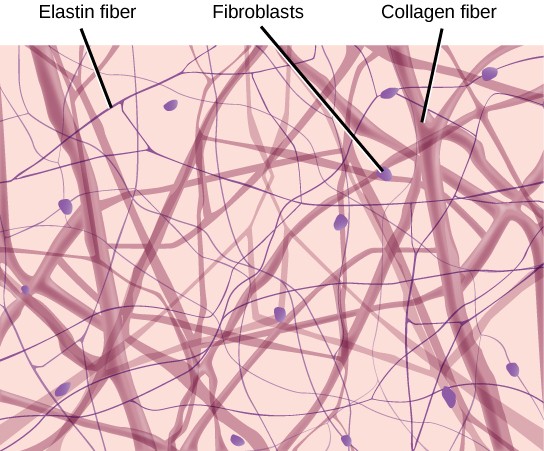
Fig. 7. Loose connective tissue
- Dense Connective tissue: As the name suggest, the cells of the dense connective tissue are tightly bound. Matrix of dense connective tissue contain fibers that are made up of collagen. For Example, tendons and ligaments. Tendons attach muscles to bones whereas ligaments connect bone to bone.
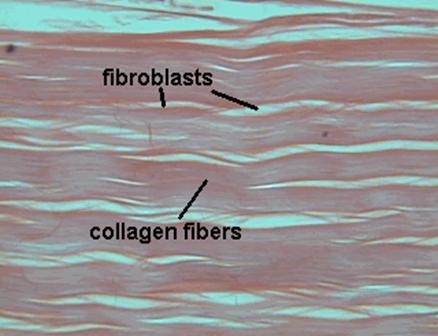
Fig. 8. Dense connective tissue
- Special Connective tissue: It includes cartilage, bones, and blood.

Fig. 9. Special connective tissue
Cartilage: It is elastic connective tissue. There are three types of cartilage found in humans – hyaline cartilage, elastic cartilage and fibrocartilage. It is meant for providing flexibility to the different parts of the body.
Bones: Bone is hard connective tissue. It is rich in calcium salts, phosphate, and collagen. Bone cell are known as Osteocytes. They give strength to the body. Helps in different body movements.

Fig. 10. Bone tissue
Blood: Blood is considered as a connective tissue because it connects different body systems for transport of oxygen, nutrients and for removal of wastes.
Cells found in the blood are as follows:
Erythrocytes or red blood cells are enucleated cells that helps in transport of oxygen and carbon-dioxide. It contains a pigment hemoglobin that helps in transport of oxygen and carbon-dioxide. The central atom found in hemoglobin is Fe2+.
Leukocytes or white blood cells are of two types – Granulocytes and Agranulocytes. Granulocytes contain granules in the cytoplasm. It includes neutrophils, eosinophils, and basophils.
Agranulocytes includes monocytes, macrophages, and lymphocytes.
Muscle tissue
It is a soft tissue that helps in body movement. Formation of muscle tissue is known as myogenesis. There are three types of muscle tissue – Skeletal Muscle, Smooth Muscle, and Cardiac Muscle. Skeletal muscles are striated muscle that helps voluntary movements of the body. Smooth muscles are non-striated muscles which helps in involuntary movements of the body. Cardia muscles are striated muscles that helps in rhythmic contraction and relaxation of heart.
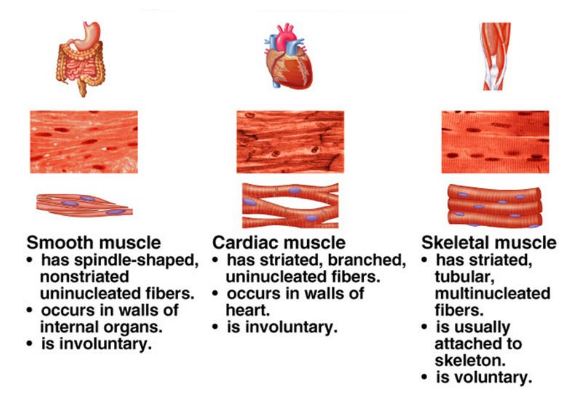
Fig. 11. Types of muscular tissue
Neural tissue
It includes tissues of the nervous system. Cells of the nervous system are known as neurons or nerve cells. They are electrically excitable cells. They are involved in nerve impulse transmission. Nervous tissue is divided into two main system- central nervous system that includes brain and spinal cord and peripheral nerve system that includes spinal nerves and cranial nerves.
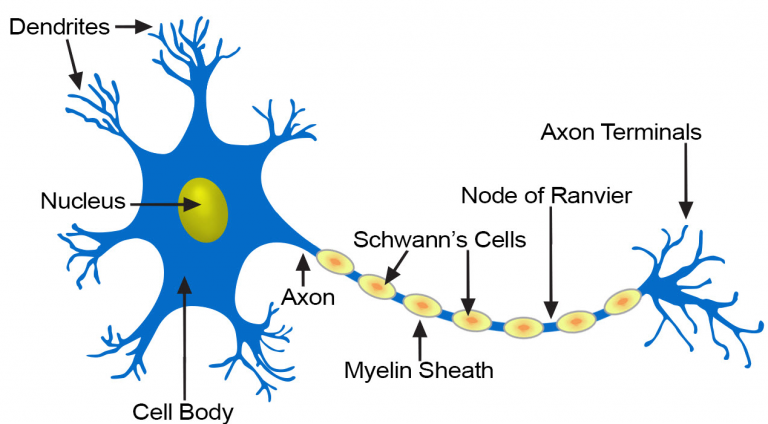
Fig. 12. Structure of neuron
Organ and Organ System
- Earthworm or Pheretima posthuma
- Cockroach or Periplaneta Americana
Earthworm or Pheretima posthuma
It is reddish brown invertebrates. It is cylindrical in structure with body divided into segments known as metameres. The anterior end of the body contains mouth and prostomium (covers the mouth). The first body segment is known as buccal segment or peristomium. A dark band of glandular tissue that covers around 14 to 16 segments of the body is known as clitellum. Setae are meant for locomotion. They are present in the middle segment but absent in the first segments. Alimentary canal is with mouth and anus.
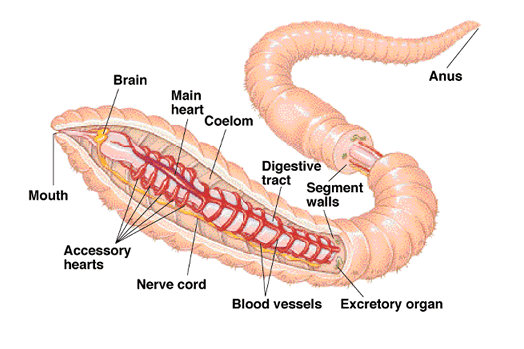
Fig. 13. Anatomical structure of earthworm
Closed type of circulatory system is found in earthworm. It consists of heart, blood vessel and capillaries. Hemoglobin is the blood pigment found in earthworms.
Nephridia are the excretory structures found in earthworm. It helps in the removal of the waste from the body.
Nervous system consists of the ventral nerve cord. Ganglia are arranged on each metamere. Absence of eye, but sensory receptors for touch and light are present.
Reproductively earthworm is hermaphrodite. Female consists pair of ovaries present in 12th and 13th segments. Male consists of pair of testis found in found in 10th and 11th segments. Fertilization is direct and external.
Cockroach or Periplaneta Americana
It is an invertebrate that is a member of Arthropoda. Its body is divided into head, thorax and abdomen. The outermost covering of the body is known as exoskeleton, which is made up of chitin. The hard plates found in exoskeleton is known as Sclerites. Anterior most part of the body is known as Head that contain mouth parts. The mouth parts consist of upper lip known as labrum, a pair of mandibles, a pair of maxillae and lower lip known as Labium.
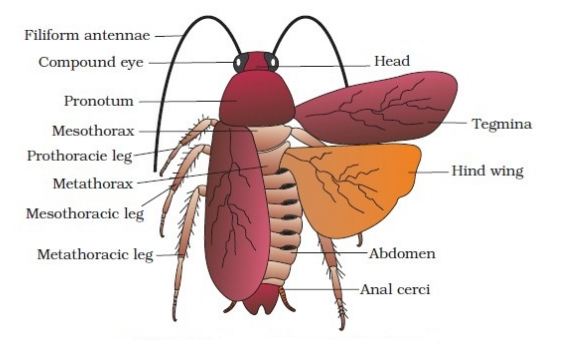
Fig. 14. Structure of cockroach
Thorax is divided into prothorax, mesothorax and metathorax. The head relates to the thorax by a short extension of prothorax known as Neck. Each thoracic segment consists of pair of walking legs. The first pair of wings is present in mesothorax and the second pair is found in metathorax. Hindwings are meant for flight.
The male and the female genital part is found in abdomen.
The alimentary canal is divided into -foregut, midgut, and hindgut.
Open type of vascular system is found in cockroach. Instead of hemoglobin, hemolymph is present.
Respiratory system contain trachea that opens through small opening known as Spiracles. Exchange of gases occurs in trachea through diffusion.
Excretory organs are known as Malpighian tubules. These tubules contain glandular and ciliated cells.
Male reproductive system consists of pair of testis present in the 4th to 6th abdominal segments. Female reproductive system consists of pair of ovaries found 2nd to 6th in the abdomen.